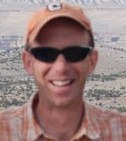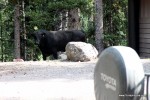No sooner had the Bears Ears National Monument been proclaimed than local Utah politicians launched a concerted effort to undo it. Kirsten Allen and her gang at Torrey House Press have gone to great lengths to help support the making of the Monument and may indeed have played a role in its creation by the President Obama and the Department of the Interior. They created and published Red Rock Testimony and took hundreds of copies to Washington D.C. They simultaneously came out with Edge of Morning, a book of all Native voices in support of the Bears Ears. These are very nice people, why would they promote an outcome that local people don’t want? Continue reading
Category Archives: National Parks, Forests and Monuments
Review: All the Wrong Places: A Life Lost and Found

All the Wrong Places: A Life Lost and Found by Philip Connors
My rating: 5 of 5 stars
ALL THE WRONG PLACES is a hero’s journey and the story of the emergence of one of the best of the West’s new writers.
I had the pleasure of meeting Phil Connors at an Association for the Study of Literature and Environment writer’s conference where he was a speaker. Dave Foreman was there too and the three of us had lunch along with my wife and publisher at Torrey House Press, Kirsten Allen. Kirsten ended up sitting with three men who had lost their brothers by their brother’s own hand. It was a moving experience for me, one I still feel and am grateful for. Continue reading
Have chairs will travel
 Except I left the chairs home. We have some great Zero Gravity camp chairs and I left them in the garage on our trip to the west desert and Fish Springs National Wildlife Refuge yesterday. Kirsten and I want to take the chairs to some of the iconic view sheds in the West and hang for awhile. We have never gone outside less often than now that we are running a land oriented publishing house. We want to remedy that. Utah sits at a triangular apex of the best scenery there is, the Rocky Mountains, the Colorado Plateau and the Great Basin. Next time we will take the chairs.
Except I left the chairs home. We have some great Zero Gravity camp chairs and I left them in the garage on our trip to the west desert and Fish Springs National Wildlife Refuge yesterday. Kirsten and I want to take the chairs to some of the iconic view sheds in the West and hang for awhile. We have never gone outside less often than now that we are running a land oriented publishing house. We want to remedy that. Utah sits at a triangular apex of the best scenery there is, the Rocky Mountains, the Colorado Plateau and the Great Basin. Next time we will take the chairs.
Yesterday was in the Great Basin. I have heard a number of times that only two percent of charitable giving goes to conservation. Yet here we live in a state that can easily be described as 98 percent scenic landscape. The disconnect from urban to open scene is sudden. Just south of Point of the Mountain on I-15 while still in the midst of the Wasatch Front urban corridor, turn west, go through a slight pass into Cedar Valley and the population density drops 90 percent. Ten more miles west of that and the population density is zero. Continue reading
The Elephant in the Room is a Cow — Grazing Impacts on So. Utah Forests
My wife and I are both sixth generation Utahns. We own homes in both Salt Lake and Wayne counties. We were married in the Capitol Reef National Park outdoor amphitheater in 2010. Together we cherish the natural landscape of Utah, our pretty, great state. Except for one thing. We have become sensitized to the damage done by livestock grazing on public lands. Our pioneer ancestors worked hard to survive in the arid country they were charged with settling, and we admire the determination and pluck it required. But public lands ranching doesn’t make sense anymore, and the more we learn about what our forests could be, the more we see the degradation–and absence–of plant communities and wildlife habitat. There is hardly anywhere we can go outside of the wilderness areas of the Wasatch where we don’t see it. This bothers us so much we started a publishing company in part to shed more light on public land mismanagement. We also volunteered with Mary O’Brien and the Grand Canyon Trust to do grazing damage assessment and now serve on the board of directors of Wild Utah Project with Allison Jones.
I borrowed the elephant part of the title to this blog piece from our neighbor in Torrey, Chip Ward, from something he said in a recent Tom’s Dispatch post about beaver habitat destruction by ranchers. Kirsten and I feel that if there is one simple, single thing that would most improve the natural landscape of Utah it would be the cessation of public land livestock grazing. It is everywhere yet its economic benefits are miniscule and for only a very few. Currently, 97% of the Dixie, Fishlake, and Manti-La Sal National Forests in southern Utah are actively grazed by livestock. But only one percent of Utah’s gross domestic product, or economic output, is agriculture, and only a small sliver of that is from public land grazing. Yet that one percent of economic production uses 82 percent of Utah’s water and almost all of the public land. Predators such as wolves, key to ecologic balance, have been eliminated. Others like coyotes, and now even crows, are hunted down by the state. Beavers have been virtually outlawed in Garfield County, just south of Wayne. Aspen, willow, and cottonwood growth have been stunted by livestock browsing. The problem is conceptually easy to fix, but it goes largely ignored. When it isn’t ignored, reform is blocked by tiny but powerful special interest groups. In the West, the iconic cowboy and his cow remain mythical and sacred. Like the king with no clothes, the public land is exposed and much the worse for it.
Over the last four or five years we have gathered photos illustrating both the damage from livestock grazing and what the forests could be when protected from grazing. Clicking any of the photos in the gallery below will take you to a slide show where more detailed captions are available. Perhaps many of the pictures need no caption to tell the story. We often photograph “exclosures,” areas fenced off to keep livestock out in order to assess grazing impacts. Virtually all of the exclosures we find are routinely violated by the ranchers — which makes sense since it makes them look bad. Cows are also supposed to be herded away from riparian areas, but in all our forest travels we have only seen the one cowboy pictured below.
The Southern Utah Forest Service is instituting a grazing assessment and inviting comments (send emails to “grazingassessment@fs.fed.us”) and concerns. We hope they take this chance to begin to run the forests as other than a subsidized ranch.

Exclosures – August 2012
Kirsten and I went up to the Fish Lake National Forest and camped on Thousand Lake Mountain in southern Utah for a couple of nights this last Thursday through Saturday August 16-18. This area is just north of Torrey and we like to get up there in the summer just to get out and to do a little volunteer assessment of the management practices on these public lands.
We came away glad to have been out but distressed at how the land is being over used particularly for grazing and logging. Working with Mary O’Brien of the Grand Canyon Trust we have become aware of how the open spaces of the public lands in the West are in a state of what Mary calls normalized degradation. I’m afraid she is right. The national forest above the Wasatch Front is managed for people. These dry desert mountains in southern Utah have a multiple use directive, but the use in fact is dominated by ranching. The contrasts are distinct. Wildflowers are hip deep all summer in the Wasatch. The southern meadows are grazed every year down to a 4″ stubble height. That’s the goal, it is usually worse. Riparian areas in particular take a beating. Because of pressure by environmentalists some small areas called “exclosures” have been set aside and somewhat protected from grazing. The ecological difference in these exclosures is tremendous. The cowboys obviously still let the cows into these protected spaces but not enough to erase the evidence of what these mountain meadows could be without public land grazing.
I have blogged about it more here and elsewhere, but the reasoning behind public land grazing defies common sense. It is not economic. The ranchers/livestock permittees depend heavily on subsidies for water, gates, fences, rangeland “treatments” and pasture control. Most of them make very little money all the same. Public land grazing is probably the number one source of public land degradation and yet the public subsidizes it. It is a story of a very narrow special interest taking advantage of the public’s clueless largesse. It has long been a problem and one that seems to be intractable. At $1.35 per AUM (Animal Unit Month – one cow and calf for a month of grazing) ranchers pay the same fee to graze as they did in 1966. Who gets such treatment today? One way out, the best one I can see, is to give ranchers a right they do not now have and allow them to accept grazing retirement buyouts. -Mark Bailey
Private Profit, Public Expense
The Salt Lake Tribune weighs in. This kind of economic nonsense of allowing an open pit coal mine on the doorstep of a favorite national park in order to create a couple hundred jobs is just what ticks off Tom Wharton in the previous post. . . . more>>
Alton coal mine: more private profits at public expense.
 Speaking of externalities, which I did implicitly in the previous blog, here’s an update on the Alton Coal mine expansion next door to Bryce Canyon National Park. Public hearings coming up. . . . more>>
Speaking of externalities, which I did implicitly in the previous blog, here’s an update on the Alton Coal mine expansion next door to Bryce Canyon National Park. Public hearings coming up. . . . more>>
More good news, this time for the Grand Canyon.
 Today Interior Secretary Ken Salazar’s issued a rule proposing to protect the Grand Canyon from new uranium claims. In 2009 Secretary Salazar placed a two-year moratorium on new uranium mining claims on a million acres of public lands surrounding the Grand Canyon, overturning a Bush administration policy that encouraged thousands of new claims when the price of uranium soared in 2006 and 2007. Many of those making claims are foreign interests, including Russia’s state atomic energy corporation. Does it weird anybody out but me that the anti-environment conservatives ,the heirs of the McCarthy era of communist hunters, thought that having Russia own an atomic energy mine in the Grand Canyon was a good idea? . . . more>>
Today Interior Secretary Ken Salazar’s issued a rule proposing to protect the Grand Canyon from new uranium claims. In 2009 Secretary Salazar placed a two-year moratorium on new uranium mining claims on a million acres of public lands surrounding the Grand Canyon, overturning a Bush administration policy that encouraged thousands of new claims when the price of uranium soared in 2006 and 2007. Many of those making claims are foreign interests, including Russia’s state atomic energy corporation. Does it weird anybody out but me that the anti-environment conservatives ,the heirs of the McCarthy era of communist hunters, thought that having Russia own an atomic energy mine in the Grand Canyon was a good idea? . . . more>>
Court upholds Clinton-era ban on forest road-building.
 In one of the most important decisions for public lands in decades, a federal appeals court Friday upheld a Clinton administration rule that bans road-building and logging on roughly a quarter of the country’s national forestland. The unanimous decision could settle one of the most contentious conservation issues of the last decade. The 2001 roadless rule, issued in the final days of the Clinton administration, generated lawsuits, conflicting court opinions and repeal efforts. This was the second ruling by a federal appeals court to uphold the Clinton action. The case could be appealed to the Supreme Court, but environmental attorneys said the ruling is so strong that it probably spells an end to the protracted legal battle over nearly 50 million acres of public forest . The folks at High Country News say that while it doesn’t amount to full wilderness designation, it is at least “Wilderness Lite.” Good news. . . . more>>
In one of the most important decisions for public lands in decades, a federal appeals court Friday upheld a Clinton administration rule that bans road-building and logging on roughly a quarter of the country’s national forestland. The unanimous decision could settle one of the most contentious conservation issues of the last decade. The 2001 roadless rule, issued in the final days of the Clinton administration, generated lawsuits, conflicting court opinions and repeal efforts. This was the second ruling by a federal appeals court to uphold the Clinton action. The case could be appealed to the Supreme Court, but environmental attorneys said the ruling is so strong that it probably spells an end to the protracted legal battle over nearly 50 million acres of public forest . The folks at High Country News say that while it doesn’t amount to full wilderness designation, it is at least “Wilderness Lite.” Good news. . . . more>>
Rural jobs and public lands
 I want to keep track of this report and blogging on it is a handy way. Here in Utah our own congressman Rob Bishop and senator, Orrin Hatch are busy in a misguided way trying to create jobs via short term direct extraction at the expense long term expense of recreation. Recreation sounds trivial compared to drilling, mining, logging or grazing. It’s not. According to the Wilderness Society outdoor recreation, natural resource conservation, and historic preservation activities contribute a minimum of $1.06 trillion annually to the economy, support 9.4 million jobs and generate over $100 billion in federal, state and local taxes. Economics aren’t the only argument for sustaining an attactive natural environment, but it is an argument that tends to get traction. . . . more>>
I want to keep track of this report and blogging on it is a handy way. Here in Utah our own congressman Rob Bishop and senator, Orrin Hatch are busy in a misguided way trying to create jobs via short term direct extraction at the expense long term expense of recreation. Recreation sounds trivial compared to drilling, mining, logging or grazing. It’s not. According to the Wilderness Society outdoor recreation, natural resource conservation, and historic preservation activities contribute a minimum of $1.06 trillion annually to the economy, support 9.4 million jobs and generate over $100 billion in federal, state and local taxes. Economics aren’t the only argument for sustaining an attactive natural environment, but it is an argument that tends to get traction. . . . more>>






































































































